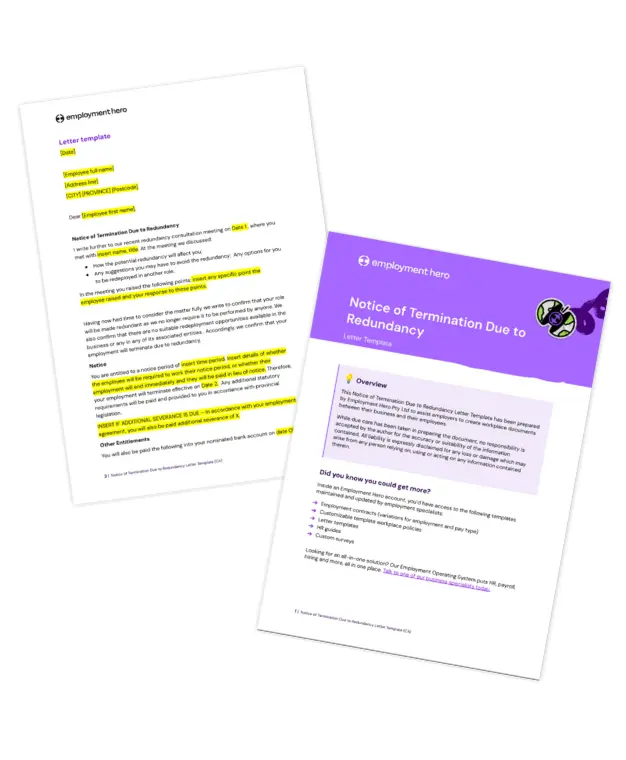Redundancy notice letter: Template for Canadian employers
Published
Redundancy notice letter: Template for Canadian employers
Published
A redundancy notice letter is a formal document an employer issues to an employee to inform them that their position is being eliminated and that their employment will be terminated. Unlike a dismissal for cause, a redundancy is a no-fault termination that occurs when a company restructures, downsizes or closes a specific business unit, meaning the role itself is no longer required.
Our downloadable template is a crucial resource for any Canadian employer navigating this difficult process. It provides a comprehensive and sound framework that you can customize to fit your specific needs. The template includes key sections on notice periods, severance pay and the return of company property, helping you improve clarity, compliance and professionalism during a sensitive time.

What does a redundancy notice mean?
A redundancy notice signals that an employee’s role has been deemed surplus to the company’s operational needs. From an employment law perspective, it is a termination of employment, but it is distinct from a dismissal for performance issues or misconduct. The decision is based on an objective business need, not on the individual’s performance.
When employers issue such notices
Employers issue these notices when they are making a position redundant, which can be due to:
- Technological changes: New technology or automation makes a role obsolete.
- Economic downturn: The company needs to reduce costs to remain viable.
- Organizational restructuring: The business model changes and certain roles are no longer part of the new structure.
In Canada, the notice must clearly state the reason for the redundancy and the effective date of termination. The length of the notice period is governed by federal or provincial laws and is based on the employee’s length of service. It should also outline any severance pay, accrued vacation and final wages owed.
Is redundancy the same as termination?
While redundancy is a type of termination, the terms are not interchangeable.
- Termination is a broad term for ending an employment relationship for any reason, including misconduct, poor performance or resignation.
- Redundancy is a specific type of termination where the employee’s position is eliminated because it is no longer needed by the business. The termination is not the result of the employee’s actions or performance.
This distinction is crucial because redundancy often carries different legal obligations for employers, particularly regarding notice periods and severance pay.
Key elements of a redundancy notice letter
A well-drafted redundancy notice letter must be clear, compassionate and compliant.
Clarity and tone
The letter should begin with a clear, concise statement that the employee’s role is being made redundant. The tone should be empathetic and professional, acknowledging the difficulty of the situation. It’s important to state that the decision is based on business needs, not the employee’s performance.
Reason for redundancy
While you don’t need to provide an exhaustive business case, the letter should briefly explain the reason for the redundancy (e.g., restructuring, automation). This provides context and helps the employee understand that the decision is not personal.
Notice period and termination date
This section must clearly state the length of the notice period and the official termination date. The letter should specify whether the employee will be required to work during this period or if they will receive pay in lieu of notice.
Severance and other entitlements
The letter must detail all payments the employee is entitled to, including severance pay, any outstanding wages and accrued vacation pay. If your company is offering a severance package that exceeds the legal minimum, this should be clearly stated. The letter should also specify when these payments will be made.
Return of company property
This section provides instructions for returning company property, such as laptops, phones, keys and access cards. It should include a specific deadline and a contact person for the return process.
Download the redundancy notice letter template
Our template is a professional and clear framework designed to simplify the redundancy process. It ensures that you cover all the necessary information, protecting your business while treating your employees with respect.

Legal considerations of employment redundancy in Canada
Canadian employment law, governed by federal and provincial statutes, sets out strict rules for redundancy.
Notice period and severance pay requirements
The minimum notice period and severance pay requirements vary significantly by jurisdiction and are based on the employee’s tenure.
| Jurisdiction | Minimum notice period | Minimum severance pay |
|---|---|---|
| Federal | Varies by tenure (e.g., 2 weeks for 2-4 years of service) | 2 days per year of service (minimum of 5 days) |
| Ontario | Varies by tenure (e.g., 1 week for 3 months-1 year) | 1 week per year of service |
| British Columbia | Varies by tenure (e.g., 1 week for 3-12 months) | 1 week per year of service |
| Quebec | Varies by tenure (e.g., 1 week for 3 months-1 year) | Based on tenure and salary |
| Alberta | Varies by tenure (e.g., 1 week for 3 months-2 years) | None specified |
Human rights considerations
Employers must ensure that the redundancy process is fair and non-discriminatory. Decisions cannot be based on protected grounds such as age, gender, race, disability or family status. A clear, objective selection process is essential to avoid potential legal challenges.
Employer obligations during redundancy
When making a role redundant, employers have several key obligations.
- Consultation: Where possible, employers should consult with employees about the redundancy, providing an opportunity for feedback or suggestions to avoid the termination.
- Fair selection: The criteria for selecting who will be made redundant must be objective and non-discriminatory. Examples of objective criteria include specialized skills or length of service.
- Consider redeployment: Employers must consider whether there are any suitable alternative roles within the company for the employee. This is a legal requirement in many jurisdictions.
- Provide legal entitlements: Ensure all statutory notice and severance requirements are met and paid in a timely manner.
Get started with our customizable template today
Handling redundancy with clarity, compliance and compassion is vital for both the employer and the employee. A well-drafted redundancy notice letter, supported by a fair and transparent process, protects your business while upholding your commitment to treating employees with dignity and respect.
FAQs
Yes, an employer can withdraw a redundancy dismissal if the business circumstances change and the role is no longer surplus. However, it’s a good practice to consult with legal counsel to ensure the process is handled correctly and to avoid potential liability.
An unfair redundancy is one where the process is flawed, such as:
- The redundancy is not genuine (e.g., the role is immediately re-filled).
- The selection process is discriminatory or lacks objective criteria.
- The employer fails to meet statutory obligations for notice and severance.
Redundancy can be categorized into three main types:
- Compulsory redundancy: The employer makes the final decision on which employees are made redundant.
- Voluntary redundancy: Employees are offered the opportunity to volunteer for redundancy in exchange for an enhanced severance package.
- Layoff: A temporary suspension of employment, often with the intent to recall employees once business conditions improve.
From an employer’s perspective, disadvantages include loss of institutional knowledge, a potential decrease in morale among remaining employees and the financial cost of severance packages and administrative overhead. For the employee, redundancy can lead to financial stress, a loss of identity and the challenge of finding a new job.
The information in this template is current as at 1 August 2025, and has been prepared by Employment Hero Pty Ltd (ABN 11 160 047 709) and its related bodies corporate (Employment Hero). The content is general information only, is provided in good faith to assist employers and their employees, and should not be relied on as professional advice. Some information is based on data supplied by third parties. While such data is believed to be accurate, it has not been independently verified and no warranties are given that it is complete, accurate, up to date or fit for the purpose for which it is required. Employment Hero does not accept responsibility for any inaccuracy in such data and is not liable for any loss or damages arising directly or indirectly as a result of reliance on, use of or inability to use any information provided in this template. You should undertake your own research and seek professional advice before making any decisions or relying on the information in this template.
Register for the template
Related Resources
-
 Read more: AI in HR: Practical ways Canadian SMBs can save time on HR & payroll
Read more: AI in HR: Practical ways Canadian SMBs can save time on HR & payrollAI in HR: Practical ways Canadian SMBs can save time on HR & payroll
Discover how AI in HR can help Canadian SMBs save time and streamline HR and payroll processes. Learn about tools,…
-
 Read more: The employee engagement checklist Canada’s top employers use
Read more: The employee engagement checklist Canada’s top employers useThe employee engagement checklist Canada’s top employers use
Download a free employee engagement checklist for Canadian SMBs. Learn how to boost morale, productivity and retention with actionable strategies.
-
 Read more: How to create an employee handbook in Canada
Read more: How to create an employee handbook in CanadaHow to create an employee handbook in Canada
Learn how to create a compliant and engaging employee handbook in Canada. Including legal essentials, policies and a free template.

















